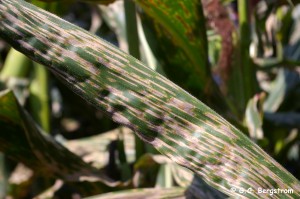Field corn is the king of crops in New York. This highest net-value and most widely grown crop occupies more than a million acres statewide. Some years it’s hammered by leaf blights that can cost considerably if not treated in time. Other years your crops get off almost unscathed. So — how to know which conditions tip the scales for health or disease on your farm — and thus whether you should spray or put that money to a different use?

A savvy farmer who knows the risks and benefits of pesticides needs ways to tell if a given fungicide will provide higher yields and profits, and under what conditions. To help, IPM researchers have taught and tested new materials that guide growers in setting up side-by-side strip trials — three or more pairs of treated and untreated corn, each strip at least 10 feet wide, so you can do your own on-farm research.
For if good judgment is the best IPM tool a farmer has, the best place to hone it is in your own fields, under your growing conditions. There’s no better way to know which combination of best-management tactics work best in the microcosm known as your farm — regardless what a specialist or salesperson might say.
Find these new protocols and their companion data sheets on our website. (Hint: both are links to pdfs.)
Special thanks to Professor Gary Bergstrom, Field Crops Pathology Extension Program, Cornell University